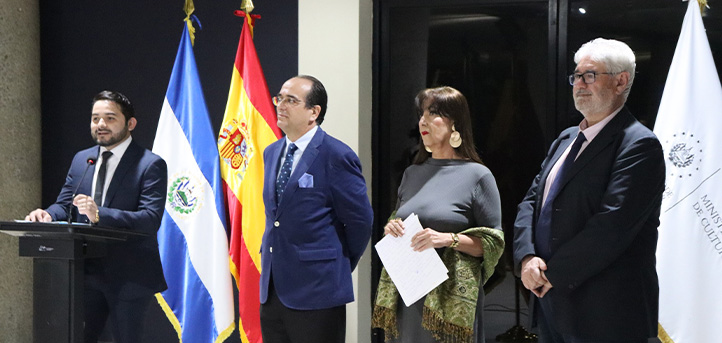The FUNIBER Cultural Work office and the Universidad Europea del Atlántico (European University of the Atlantic, UNEATLANTICO), in collaboration with the Ministerio de Cultura de El Salvador (Ministry of Culture of El Salvador) and its Embassy in Spain, inaugurated the exhibition “Tàpies, colección del grabador Barbarà” (Tàpies, a collection by engraver Barbarà) at the Museo Nacional de Antropología Dr. David J Guzmán (MUNA) (Dr. David J Guzmán National Museum of Anthropology) in San Salvador.
The showroom will be open to the public from March 6 through May 25. The opening ceremony was presided by Alejandro Herrera, director of FUNIBER’s office branch in El Salvador, Astrid Bahamond, National Director of Museums and Exhibition Halls, Marieem Eunice Pleitez, Minister of Culture of El Salvador, Carlos de la Morena Casado, Spanish Ambassador to El Salvador, and Roberto Ruiz, Vice Rector of International Relations of the Universidad Europea del Atlántico (UNEATLANTICO).
“This is an interesting exhibition, quite raw. It is a contrast that highlights both the life, death and suffering that the artist perceived. It really is quite shocking. I didn’t know the artist, and here I have had the opportunity to soak up this type of art,” said one of the attendees during the opening gala.
According to Federico Fernández, director of the FUNIBER Cultural Work and UNEATLANTICO, the importance of this collection “lies in its uniqueness”. The works cover a wide stylistic repertoire of the author, “being able to appreciate several of his creative phases”.
The exhibition “Tàpies, colección del grabador Barbarà” contains 29 engravings from the collection of the outstanding engraver Barbarà. Its common feature is the renowned Barcelona painter and engraver Joan Barbarà (1927-2013) and one of the most outstanding Spanish artists of the 20th century, Antoni Tàpies (1923-2012).
A noteworthy aspect of the collection, which brings the series together, is that most of the prints are signed by Antoni Tàpies. Fernández emphasizes that he acquired the works directly from Barbarà’s sons, and that the fact that they are Bon à tirer is an aspect he is proud as it highlights its quality. He also points out that the collection shows a representation of Tàpies’ stylistic evolution, from the times of Dau al Set (1948) to the 1980s.
The exhibition coincides with the celebration of Tàpies’ 100th birthday. Promoted by the Fundación Antoni Tàpies (Antoni Tàpies Foundation), the objectives of this event are to approach the work and the artist’s thoughts in depth, disseminating both nationally and internationally, and contributing to the renewal of its interpretations and constructing new perspectives
This type of cultural activities enriches the knowledge of nations, due to the type of masterpiece they represent and all the context behind them, apart from being important for human history. The works emphasize the importance of critical thinking, participating in the knowledge society, educating people capable of learning on their own, and being critical when applying their knowledge in real-world contexts.


